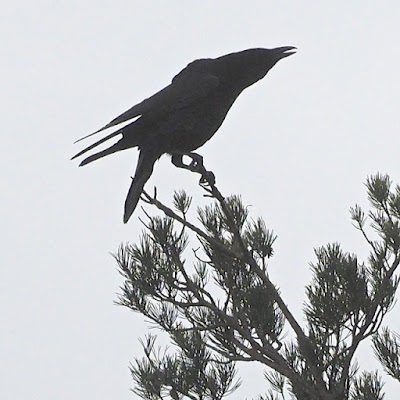There are a few bird species that sadly no longer or very rarely appear in our woods. Climate change and the changing nature of woodlands are thought to be the main drivers of the changes that are also occurring nationally. Since we bought the wood in 2005, Willow Warblers are no longer seen or heard, Spotted Flycatchers and Turtle Doves appear in just ones or twos and Marsh Tits are very hard to find. Deer numbers have increased dramatically and their browsing diminishes the richness of woodland ground flora and here in the South East, in spite of these wet winters, our woods are getting drier. But there are pluses too. Nowadays it is rare not to see a Buzzard on a visit and in early summer up to six can be spotted soaring together on a thermal. Great Spotted Woodpeckers have also increased in numbers, perhaps benefitting from the lack of management in areas of the woods and ageing of trees there, producing better nesting opportunities. But best of all, the king of the crows, the Raven, is back. Like the Buzzard it is an unusual visit when I do not now hear a Raven croaking or see one in flight. Last week two were perched at the top of Big Red, our tallest Coast Cedar and it is very likely that the pair have established a territory in Old Park Wood and may have bred in previous years. They are such enigmatic birds and it is great to know that they are around again.
 |
| A Raven announcing its presence |
 |
| A characteristic Raven profile with huge bill and wedge shaped tail |
Away from Crow Wood, Covid restrictions mean that more of my birding has to be very local, but that is not necessarily a bad thing. Recent reports suggest that Starling numbers have decreased dramatically across Europe but thankfully it is still possible to witness the great spectacle they put on in a few places across the UK, and luckily there is a site close to home where a murmuration happens most winters. The roost is in trees behind a series of water filled pits just outside Tonbridge in the Medway floodplain. The pits, still worked occasionally, were used for gravel extraction and being off the beaten track they provide a safe haven for the Starlings, which arrive there in really big numbers. Just before dusk they perform their dazzling aerial display. It is estimated that the flock contains up to 7000 birds and yesterday afternoon the display was particularly stunning as the birds wheeled around over the pits before finally dropping down en masse to roost. Brilliant.
 |
| The Starlings starting to gather |
 |
| the murmuration at its height, groups forming and re-forming |
 |
| The last group, looking to settle in the trees |











Comments
Post a Comment
Thank you for your comments: